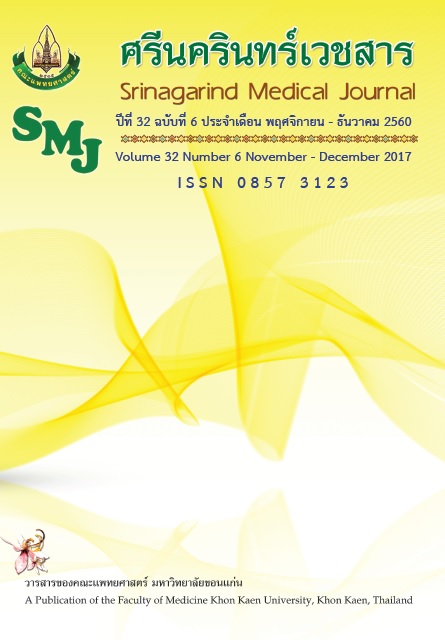Clinical Nursing Practice Guideline for Acute Pain Management in Critically Ill Patients
Keywords:
Critically ill Patients; Clinical Nursing Practice Guideline; Acute Pain Management; ผู้ป่วยวิกฤต; แนวปฏิบัติการพยาบาล; การจัดการความปวดเฉียบพลันAbstract
Background and Objective : Critically ill patients are exposed to many therapeutic or diagnostic procedures that can produce painful and distressing experiences. This study aimed to evaluate the effects of implementing a clinical nursing practice guideline (CNPG) for acute pain management among the critically ill patients
Method: This quasi-experimental study is pretest-posttest design for evaluated the effects of implementing CNPG in two groups of patients in the Semi-critical care medical ward of Srinagarind hospital during February and April 2017. Subjects consisted of 60 critically ill patients receiving routine pain management, 60 critically ill patients receiving pain management based on the CNPG for acute pain management and 21 registered nurses who implemented the CNPG. Research instruments included the CNPG for acute pain management, and data collection forms that gather demographic information and information related to the CNPG outcomes. Descriptive statistics were used to summarize the data. Chi-squares, independent t-test and relative risks were calculated to compare effects of implementing the CNPG between two patients groups.
Results : patients who had their pain managed based on the CNPG protocol were 55.5 times more likely to receive comprehensive pain assessment compared to those received routine care(98.3% vs 8.3%, RR = 55.5, 95% CI = 7.86-384.7).They were 2.3 times more like to received pain management (82.8% vs 52.3%, RR =2.3, 95% CI = 1.4-3.8) and 2.56 times more likely to be reassess for pain after pain management intervention (61.7% vs 1.7% r, RR =2.5, 95% CI =1.8-3.54). In addition, patients cared by the CNPG reported higher level of satisfaction with pain management than their counterparts (86.1% vs 72.5%, p = 0.059). However, the average pain reductions after pain management were not different between the two groups (3.5 vs 3.6, p = .277). Furthermore, nurses who implemented the CNPG had increased proportion of complete and regular pain management documentation (36.7% vs 26.7, p =.242). Nurses reported high level of feasibility for implementing the CNPG in actual practice (87.1%) and had a moderately high level of CNPG adherence (71.2%).
Conclusion : This study reflects this CNPG is effective for acute pain management among critically ill patients. They more likely to received pain assessment, received pain management and higher level of satisfaction with pain management. But the average pain reductions after pain management were not different because this CNPG don’t have the suggestion for specific management for cause of pain. So that researcher should be developing of CNPG for reduction pain in critically ill.




